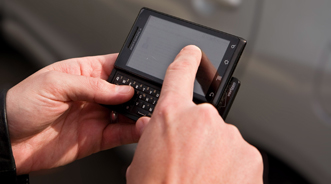Manheim Rolls Out Android App

By subscribing, you agree to receive communications from Auto Remarketing and our partners in accordance with our Privacy Policy. We may share your information with select partners and sponsors who may contact you about their products and services. You may unsubscribe at any time.
ATLANTA –
Dealers who use Google Android smartphones now can access Manheim’s suite of digital products and services like their counterparts who have iPhones.
Manheim officials explained Wednesday that now Android device users can scan vehicle identification numbers, view the vehicle summary page, view Manheim Market Report (MMR) results, search for vehicles by inventory or location, place bids, buy now, make an offer, proxy bid and use all of Manheim’s mobile tools.
The company said nearly 1,000 unique visitors have used the app in the past week.
Officials reiterated that the Manheim mobile app can simplify the research, buying and selling process for customers. It can allow them to do all of their auction preparation work and conduct all of the necessary business transactions anytime and anywhere — outside of the auction or even in the lane.
“I use a Droid X, and what impressed me most was how easy the Manheim app is to use and how well it works with the phone’s camera to scan VINs and retrieve vehicle information,” shared Ken Robinson of Ken’s Toyota Kars in Laramie, Wyo.
“I barely had to hold the app over the bar code and zap. It scanned the VIN right away. This will help me be more efficient as I research and buy cars,” Robinson added.
Subscribe to Auto Remarketing to stay informed and stay ahead.
By subscribing, you agree to receive communications from Auto Remarketing and our partners in accordance with our Privacy Policy. We may share your information with select partners and sponsors who may contact you about their products and services. You may unsubscribe at any time.
Manheim said the VIN scan significantly changes the way customers do business by making everything easier.
For example, after scanning a VIN — or entering a VIN manually — customers can view a vehicle summary page that can provide them with instant access to MMR results and information from an array of reports such as AutoCheck, Carfax, seller disclosures and/or condition reports.
Furthermore, officials pointed out that the vehicle summary page can give customers quicker access to Manheim inventory because it can provide them with the ability to start the bidding or buying process right after scanning a VIN.
Manheim emphasized the expansion into the Android marketplace is an example of how the company aligned its mobile strategy with mobile consumer trends.
For example, the company contends that 55 percent of people who purchased a mobile phone in the past three months reported buying a smartphone instead of a traditional cell phone — a 34-percent uptick from last year.
In addition, Manheim believes 38 percent of smartphone users are on the Android platform while 27 percent use the iPhone.
Manheim launched its app for iPhones last year. And by supplying the Manheim app to the Android marketplace this year, officials think Manheim’s mobile marketplace now canvases approximately 65 percent of U.S. smartphone users.
Amy Mills, senior director of product management at Manheim Digital, said the addition of the Manheim app in the Android marketplace expands the scope and reach of Manheim’s digital marketplace, and it allows Manheim to provide its customers with a comprehensive suite of mobile offerings no matter what mobile device they use.
“We noticed that customer adoption of the Android platform in the smartphone market has and continues to grow significantly,” Mills indicated.
“Making the Manheim app — which until recently was only available to iPhone customers — available to the Android marketplace was the next logical step as we work to optimize the Manheim experience for the mobile devices our customers use most,” she added.
Webb’s Take on Latest U.S. Economic Behavior
With Wednesday marking the final day of August, Manheim chief economist Tom Webb offered his assessment of macroeconomic trends.
“The odds of a near-term recession increased dramatically over the past month as an already slow economy promises to be buffeted by increasingly strong and unpredictable forces,” Webb cautioned.
“The Federal Reserve appears ready to use any and all tools to prevent a downturn, but fiscal stimulus is no longer a viable option. Consumer caution has risen along with their concerns. As a result, the important back-to school shopping season was a disappointment,” he continued.
“Surprisingly, given the economic backdrop, new- and used-vehicle retail sales continue to improve,” Webb emphasized. “To be sure, the gains are off a low base, and we are not yet near normal (or even replacement) demand. But with stagnant incomes, declining consumer confidence and a depressed labor market, dealers have done well to achieve higher unit volumes. Monthly wholesale used vehicle values continue to decline sequentially, but remain above their year-ago levels.
“Although we expect further monthly declines, relatively (and historically) speaking prices will remain exceptionally strong,” he concluded.


